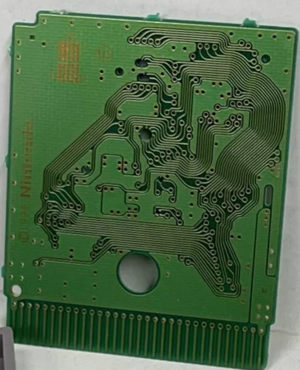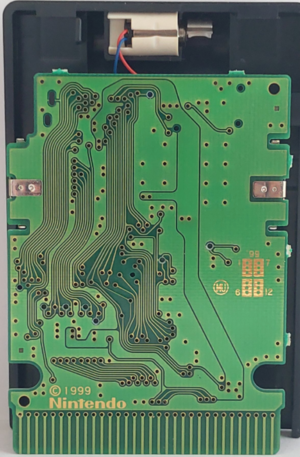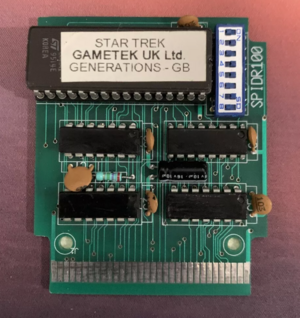Gameboy Developer Cartridge Variants
There are various different kinds of Gameboy prototype or development cartridge.
This page was written for the intent of ensuring that the variants are documented as best as possible.
Many of the images below are sourced from varying seller listings at Yahoo Auctions, Mercari, or Ebay.
notice: As Gameboy prototype and developer cartridges are over 20 years old, the information about them is obscure and difficult to ascertain. This info below may not be the same for all variants of the boards.
EP-ROM: DMGC-MBC1-2M-01 and DMGC-MBC2-2M-02 1989
prototype white label: DMG-B02-01 1998
Standard white Label: DMG-B02-12 1998
Rumble G/A-S: DMG-B03-11 1999
Blue G/A-I: DMG-B04-02 2000
EP-ROM board 01:
The EP-ROM variant of the Gameboy flash Cartridge Board typically has a large protruding EP-ROM chip at the top, exposing the internals of the board in a fashion that will become common in the other forms of the Gameboy Developer cartridge. In many cartridges the Flash of the EEP-ROM chip is exposed, which can be very dangerous for the data that may be contained.
The EP-ROM might have various model numbers, many are very faded.
There may be a copyright of 1988 from AMD.
It appears there is no standard front label.
Below the EEP-ROM is an ID code indicating either DMGC-MBC1-2M-EPROM-01.
The year on the back of the board indicates 1989 at the top right.
The MBC1 chip appears to be a DMG MBC1B Nintendo S91263A chip or a MBC1B1 Nintendo S9311 1A
possible EP-ROM ID codes are: AM27C010-205DC 12.5V PGM 934DYV3 with an unknown manufacturer.
Another example might be D27C10010-20 8747EX002 made by NEC, or D27512-200V05 U742238MS OO 1 '85.
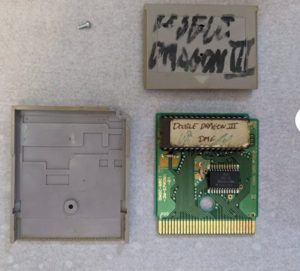
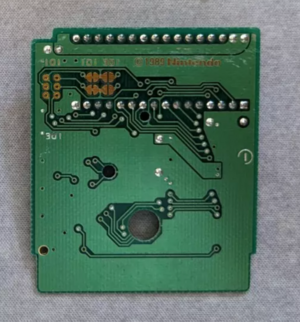
EP-ROM Board 02:
The EP-ROM variant of the Gameboy flash Cartridge Board typically has a large protruding EP-ROM chip at the top, exposing the internals of the board in a fashion that will become common in the other forms of the Gameboy Developer cartridge. In many cartridges the Flash of the EEP-ROM chip is exposed, which can be very dangerous for the data that may be contained.
much like the 01 board, It appears there is no standard label.
The EP-ROM chip appears to be a D27C20010-12 9325FD115 made by NEC.
Below the EP-ROM chip are some additional chips and a battery, as well as an model number. The model number reads as: DMGC-MBC2-2M-EPROM-02.
the copyright year appears to be 1989.
The MBC2 chip appears to be a DMG MBC2A NINTENDO S9205 5 AB.
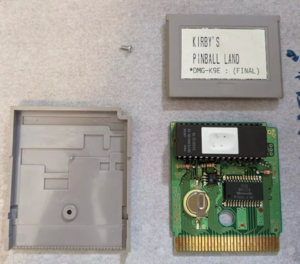
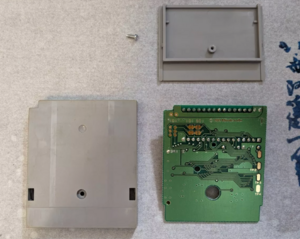
prototype white:
The prototype white Gameboy dev cartridge has an opening in the front for easy dip switch access, and a white label indicating "DMG-MBC5-32M-FLASH" but without a sub-type.
The prototype white Gameboy Board has varying chips on it.
Most prominently at surface value is an MBC-5 Chip. Unfortunately, there is a sticker covering specific chip info.
Below the MBC-5 board is an LH28F032SUTD-10 made by Sharp with the text U1 32/16/8M Flash Memory below it.
Below that is the model number DMG-B02-XX. In this case, it is 01
There is some text in the center of the board indicating MM1026 6129A 8860
On the dip switch component is 6 switches, and the absense of an R1 chip immediately next to it. While an R1 function does exist, it appears to be different than the other boards.
The battery is a CR1616.
The SRAM chip is comprised of 1M, where M = Megabits.
The SRAM Chip is an M5M510085KY 70LL.
In the upper right, there is at least one number from 1-6 indicating possibly a version of some kind.
The back of the board appears to have a year on the bottom center indicating 1998.
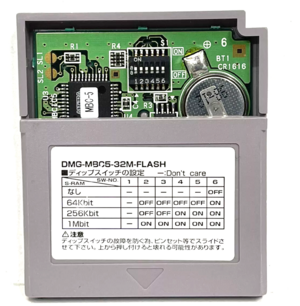

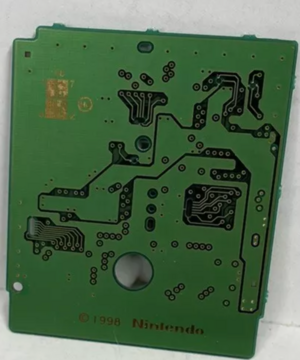
White board:
The standard white developer cartridge for the gameboy has a white label on it with the identification of "DMG-MBC5-32M-FLASH" and G/A on it.
The MBC-5 chip is marked as the MBC5-D LZ9GB34 9910B chip.
The flash memory is the same chip as the prototype board; an LH28F032SUTD-10 made by Sharp with the text U1 32/16/8M Flash Memory below it.
Below that is the model number: DMG-B02-XX. In this case, its DMG-B02-10.
On the dip switch component is 6 switches, with an R1 chip immediately next to it.
The SRAM is an M5k510085KV.
the battery is a CR1616.
In the upper right, there is at least one number from 1-6 indicating possibly a version of some kind.
In the near center is an MM1134 chip bearing the ID code 6129A
The back appears to have the copyright year of 1998 in the upper left of the board.
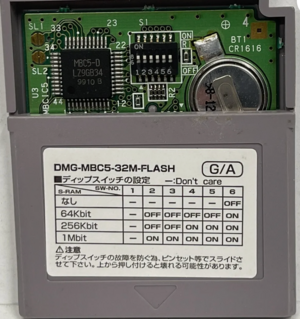
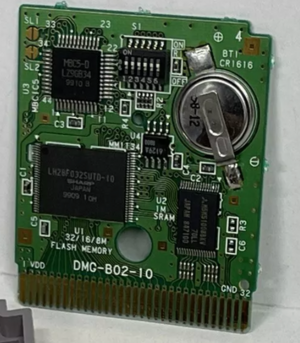
Blue board:
The Blue developer board has significant differences from the white or white protoype boards, but it also has some similarities.
The label of the cartridge indicates that its
The Label of the cartridge indicates that it is a "DMG-MBC5-32M-FLASH" as well as a G/A-I variant of the board.
At the top left of the board, it has text etched indicating MBC5DEV.
Underneath the MBC5DEV text is the MBC5-D LZ9GB34 chip, however this indicates that its a 9943B series vs the 9910 B series.
The flash memory is an Intel DA28F320J5 flash chip copyright 1997 with the text etched below: UI 64M FLASH.
On the dip switch component is 6 switches, with an R1 chip immediately next to it.
The SRAM chip is a M5M51008CKY chip indicating a 70H 003100 with a max of 1M on it.
The battery is a CR1616.
In the upper right, there is at least one number from 1-6 indicating possibly a version of some kind.
Next to the number is the model number, of DMG-B04-XX. In this case, DMG-B04-02.
In the near center is the text MM1026 with a chip next to it indicating 6735 9100
The back bears the copyright year of 2000.
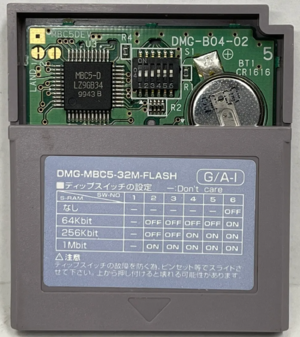
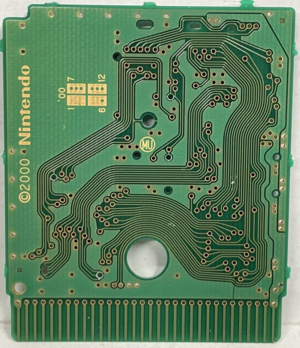
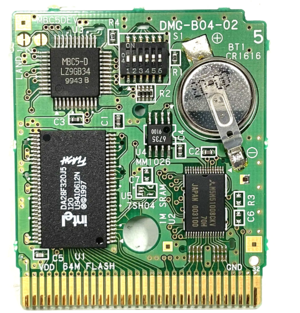
Orange or yellow board:
The Label of the cartridge indicates that it is a "DMG-MBC5-32M-FLASH" as well as a G/A-S cartridge variant.
Little is known at this time about the Orange or Yellow boards, but it seems that they are similar, if not the same, as the standard white boards.
Both seem to contain the MBC5-D LZGB34 9910 B MBC5 chip.
the R1 is next to the dip switches.
Both seem to contain a CR1616 battery as well.
In the upper right, there is at least one number from 1-6 indicating possibly a version of some kind.
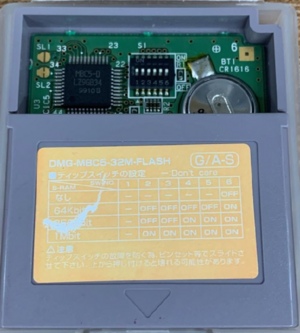
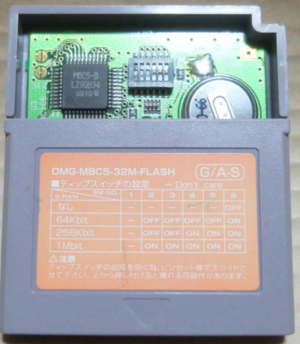
Orange/yellow Rumble board:
The rumble cartridge appears to have a longer, different form factor than the others.
The label at the top of the front of the case appears to say "DMG-MBC5-32M-R-FLASH" and G/A-S
The MBC5-D chip is an LZ9GB34 9938 B chip.
The text MBC5 DEV is on the board, similar to the blue board.
There is room for an AA battery towards the center of the board.
Underneath where the battery would go, is the model number indicating DMG-B03-XX, or in this case, DMG-B03-11.
The dip switches, unlike with the previous boards, indicates 4 dip switches as opposed to 6.
Text similar to the previous boards can be found indicating MM1134.
The memory chip is an LH28F320SKTD-L70 9928-T0K chip made by Sharp.
above the memory chip is some text indicating 32M/16M/8M.
The SRAM appears to be a single setting of 256K.
The battery is a CR1616.
The back of the board indicates a copyright year of 1999.
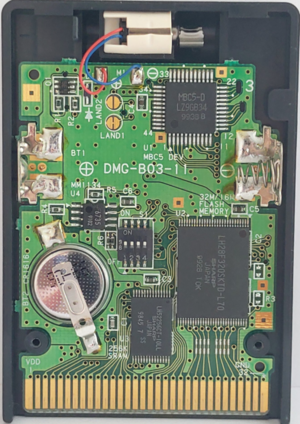
Other form factors:
There may be additional form factors for gameboy developer cartridges, or custom versions.
Examples of these are the very tall gameboy dev carts, or the custom variants used by Gametek, and possibly a megaman 4 cartridge from Capcom in which the EP-ROM might say TOSHIBA TC57400AD-120 JAPAN 9305EAK VPP12.5Y.
A board custom made by Gametek or by someone contracted in Korea was able to make an EP-ROM and presumeably a board with 8 dip switches.
The board has 4 SRAM chips, all untitled.
The boards ID code is SPIDR100.
This board has silver pins at the bottom and the back has a black shroud over it with a sticker saying "108"
